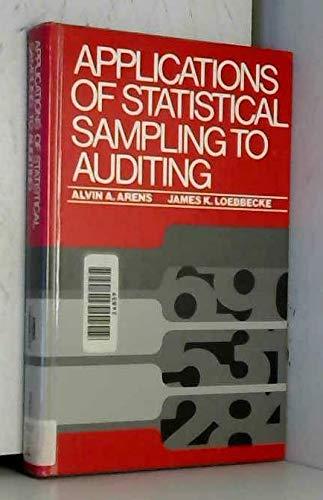The following problems apply to stratified sampling. Choose the best response. a. Mr. Murray decides to use
Question:
The following problems apply to stratified sampling. Choose the best response.
a. Mr. Murray decides to use stratified sampling. The basic reason for using stratified sampling rather than unrestricted random sampling is to
(i) Reduce as much as possible the degree of variability in the overall population
(ii) Give every element in the population an equal chance of being included in the sample
(iii) Allow the person selecting the sample to use his own judgment in deciding which elements should be included in the sample
(iv) Reduce the required sample size from a nonhomogeneous population
b. What is the primary objective of using stratification as a sampling method in auditing?
(i) To increase the confidence level at which a decision will be reached from the results of the sample selected
(ii) To determine the occurrence rate for a given characteristic in the population being studied
(iii) To decrease the effect of variance in the total population
(iv) To determine the precision range of the sample selected
c. From prior experience, a CPA is aware of the fact that cash disbursements contain a few unusually large disbursements. In using statistical sampling, the CPA’s best course of action is to
(i)Eliminate any unusually large disbursements that appear in the sample
(ii)Continue to draw new samples until no unusually large disbursements appear in the sample
(iii) Stratify the cash disbursements population so that the unusually large disbursements are reviewed separately
(iv) Increase the sample size to lessen the effect of the unusually large disbursements Problems d through h apply to an examination by Robert Lambert, CPA, of the financial statements of Rainbow Manufacturing Corporation for the year ended December 31, 1983. Rainbow manufactures two products, A and B. Product A requires raw materials that have a very low per-item cost, and product B requires raw materials that have a very high per-item cost. Raw materials for both products are stored in a single warehouse. In 1982, Rainbow established the total value of raw materials stored in the warehouse by physicafy inventorying an unrestricted random sample of items selected without replacement.
Lambert is evaluating the statistical validity of alternative sampling plans Rainbow is considering for 1983. Lambert knows the size of the 1982 sample and that Rainbow did not use stratified sampling in 1982. Assumptions about the population, variability, specified precision (confidence interval), and specified reliability (confidence level) for a possible 1983 sample are given in each of the following five items. You are to indicate in each case the effect upon the size of the 1983 sample as compared to the 1982 sample.
d. Rainbow wants to use stratified sampling in 1983. (The total population will be divided into two strata, one each for the raw materials for product A and product B.) Compared to 1982, the population size of the raw materials inventory is approximately the same, and the variability of the items in the inventory is approximately the same. The specified precision and specified reliability are to remain the same.
Under these assumptions, the required sample size for 1983 should be (i) Larger than the 1982 sample size (ii) Equal to the 1982 sample size (iii) Smaller than the 1982 sample size (iv) Of a size that is indeterminate based upon the information given
e. Rainbow wants to use stratified sampling in 1983. Compared to 1982, the population size of the raw materials inventory is approximately the same, and the variability of the items in the inventory is approximately the same. Rainbow specified the same precision but desires to change the specified reliability from 90% to 95%.
Under these assumptions, the required sample size for 1983 should be (i) Larger than the 1982 sample size (ii) Equal to the 1982 sample size (iii) Smaller than the 1982 sample size (iv) Of a size that is indeterminate based upon the information given
f. Rainbow wants to use unrestricted random sampling without replacement in 1983. Compared to 1982, the population size of the raw materials inventory is approximately the same, and the variability of the items in the inventory is approximately the same. Rainbow specifies the same precision but desires to change the specified reliability from 95% to 90%.
Under these assumptions, the required sample size for 1983 should be (i) Larger than the 1982 sample size (ii) Equal to the 1982 sample size (iii) Smaller than the 1982 sample size (iv) Of a size that is indeterminate based upon the information given g. Rainbow wants to use unrestricted random sampling without replacement in 1983. Compared to 1982, the population size of the raw materials inventory has increased, and the variability of the items in the inventory has increased. The specified precision and specified reliability are to remain the same.
Under these assumptions, the required sample size for 1983 should be (i) Larger than the 1982 sample size (ii) Equal to the 1982 sample size (iii) Smaller than the 1982 sample size (iv) Of a size that is indeterminate based upon the information given h. Rainbow wants to use unrestricted random sampling without replacement in 1983. Compared to 1982, the population size of the raw materials inventory has increased, but the variability of the items in the inventory has decreased. The specified precision and specified reliability are to remain the same.
Under these assumptions, the required sample size for 1983 should be (i) Larger than the 1982 sample size (ii) Equal to the 1982 sample size (iii) Smaller than the 1982 sample size (iv) Of a size that is indeterminate based upon the information given
Step by Step Answer:

Applications Of Statistical Sampling To Auditing
ISBN: 9780130391568
1st Edition
Authors: Alvin A. Arens, James K. Loebbecke




